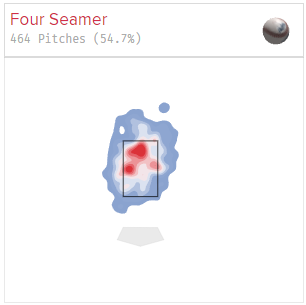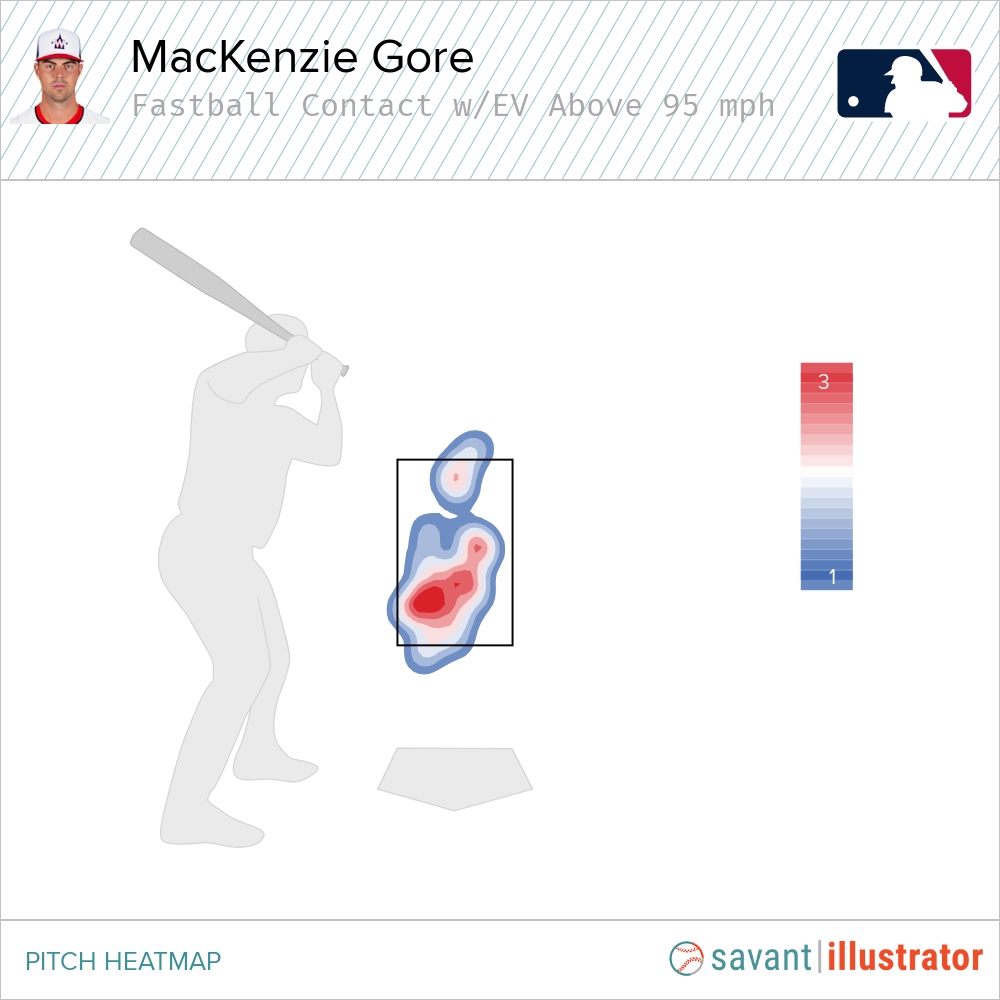Like many highly touted high school prospects, MacKenzie Gore had a magnifying glass on his career well before he was drafted. He posted an absurd 0.20 ERA in his senior year of high school, en route to Gatorade National Player of the Year, before becoming the #3 pick of the 2017 draft by the Padres. Although high school pitching prospects take the longest to develop (and are the most volatile), the expectations were sky-high. Some evaluators hypothesized he’d be in the big leagues at 20.
There was some skepticism after 2018 in Single-A, where he posted a 4.45 ERA, but the hype took off the next year when he dominated High-A to the tune of a 1.02 ERA in 79.1 innings. Naturally, after starting to rise through the Padres farm system, the 2020 season threw his development a twist. He was on the Padres taxi squad, so while he got to face live hitters, it wasn’t real competition.
Upon returning to real games in 2021, the wheels completely fell off. His walk rate ballooned from 7.5% to 18%, and his development needed re-evaluation. While Gore couldn’t definitively pinpoint the root of the issue, he needed a reset. At 22, he returned to the Padres Spring Training complex for two months to work on his mechanics, a place he pitched at for a mere 21 innings five years prior.
The hard work was rewarded with a call-up in 2022, but 70 underwhelming big-league innings later, he would be shipped across the country alongside CJ Abrams and others in the Juan Soto megadeal. After a 4.42 ERA in 136.1 innings last year, Gore seemed to be settling in as a mid-rotation starter.
This year, we’ve seen him reach back to hint at the potential we all saw six years ago. In 46.1 innings, Gore has a 3.30 ERA with a 27.1 K% and 8% BB%. His 19.1% K-BB% ranks 23rd among qualified starters, indicating that he’s earned that success so far. Gore is now showing his front-of-the-rotation potential with consistent mechanics, better fastball velocity and location, and emerging secondary pitches.
Major League Mechanics
When Gore went viral in his draft year, it was highlighted by his otherworldly leg kick.
He brings his kneecap up to almost shoulder height, and the glove is above his head at the peak of delivery, creating an imposing figure on the mound. These mechanics took him into 2021 before he needed to find new mechanics. With these extreme movements, Gore struggled to consistently repeat his delivery despite gaining strength and athleticism. Post- “reset,” Gore had a different windup and didn’t bring his hands as high but kept the leg kick.
He also moves into a pitching position differently. Compared to his previous delivery, where he brought his right foot behind him before the leg lift, Gore now keeps his right foot in line with his body. This is similar to pitching from the stretch, which likely helps his consistency.
We’ve seen even more alterations to the delivery this year: the leg kick is starting to come down.
Gore’s drive leg does not contact his torso upon its peak, which can indicate that he has more body control. Although these are small changes, they have given Gore stronger command. He’s able to put pitches where he wants to more frequently, and that’s reflected in a 3.5% increase in zone rate, now at 53.1%.
Elevated Fastballs
The fastball is the biggest recipient of improved command, which has found another level in 2024. It also helps to be up 1.5 mph, now at 96.6 mph, ranking as the second hardest left-handed fastball among starters, only behind Garrett Crochet. With 7 feet of extension (86th percentile), 17.3 inches of iVB (83rd percentile), and +1.2 height-adjusted VAA (78th percentile), the fastball has all the makings of being an elite pitch. Its 135 Stuff+ ranks as the second-best fastball among qualified starters, proving its exceptional shape and velocity.
However, it has only returned 26.1 CSW% and 42.6% ICR, which isn’t anything special. Part of that can be attributed to throwing the fastball 54.7% of the time, so it will likely run into trouble at some point, but it should be better. It also has a .373 BABIP, and +7 hit luck, indicating there’s been some bad luck, too.
But Gore is elevating the fastball more now and getting whiffs. The pitch is now located in the upper half of the zone 50.9% of the time, up a tick from last year. Combining location with extra velocity has led to a 15% decrease in out-of-zone contact rate, which yields a 2% increase in whiff rate and a 3.5% increase in chase rate from last year.

While the biggest spot on the heatmap is up, Gore still has this secondary red spot for the fastball: down-and-in to righties. This has been the core of the hard contact he’s given up to righties.

He’s elevating more but still has room to improve on this front. If he can elevate even more, the fastball will continue to yield whiffs, but also called strikes. A 13.4% called strike rate for a fastball is in the 19th percentile among starters. He’s still seeing success with this approach, so there’s more in the tank and that elite fastball production looms in the future.
Emerging Secondaries
Gore’s fastball is special, but he needs other pitches to make his game work as a starter. The curveball and slider, which have improved this year, are crucial for Gore to become more polished.
His curveball, which he throws 20% of the time, has become the called strike pitch in his arsenal. He gets called strikes at a 23.7% clip, which is in the 67th percentile among starters’ curveballs, a 9% increase from last year
He can get called strikes with the curveball because it tunnels well with the high fastball, another reason Gore should elevate that pitch more.
The focus on called strikes has reduced whiffs: the curve has lost 10% in chase rate and 7% in whiff rate. That, however, sets up the slider to get whiffs.
Gore rarely throws his slider in the zone, but it doesn’t matter. The pitch is now up 3 mph to 91.6 mph, the hardest left-handed slider among starters. He does an excellent job at keeping it glove-side, but it often travels too far off the plate. It only has a 28.8% zone rate (8th percentile) but has a 35% whiff rate (64th percentile).
Both breaking pitches have respectable ICRs under 40%, meaning they can also suppress contact. Using these pitches in tandem off the fastball allows Gore to control at-bats, but it comes down to getting ahead in the count. Not many hitters can handle a near-92 mph slider, but he has to get into situations where he can use it.
Gore has the tools: an elite fastball, two potential breaking balls, and sound mechanics. His locations have improved from last year, but we’re still on the runway before takeoff. If the fastball gets elevated with consistency, the rest of the arsenal can supplement at-bats with called strikes and whiffs, pushing Gore closer to that potential we’ve all been waiting for.
